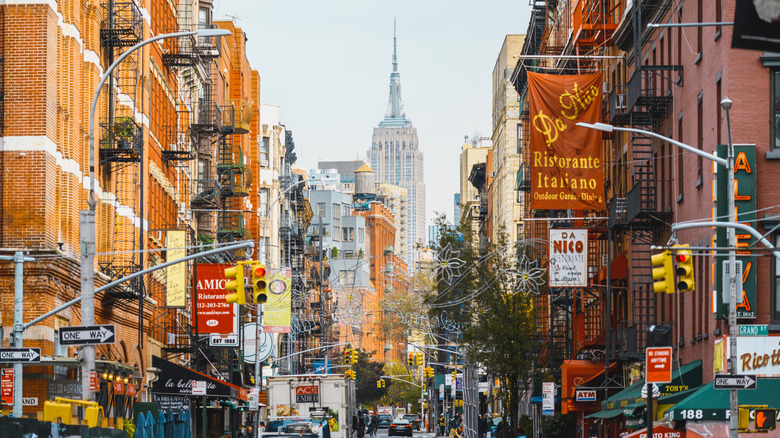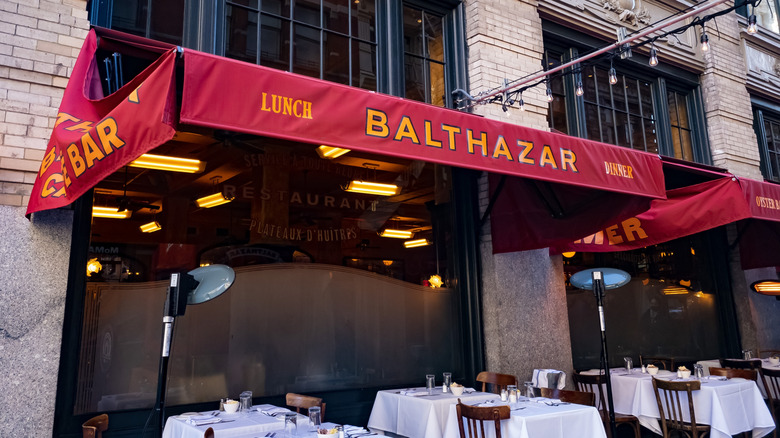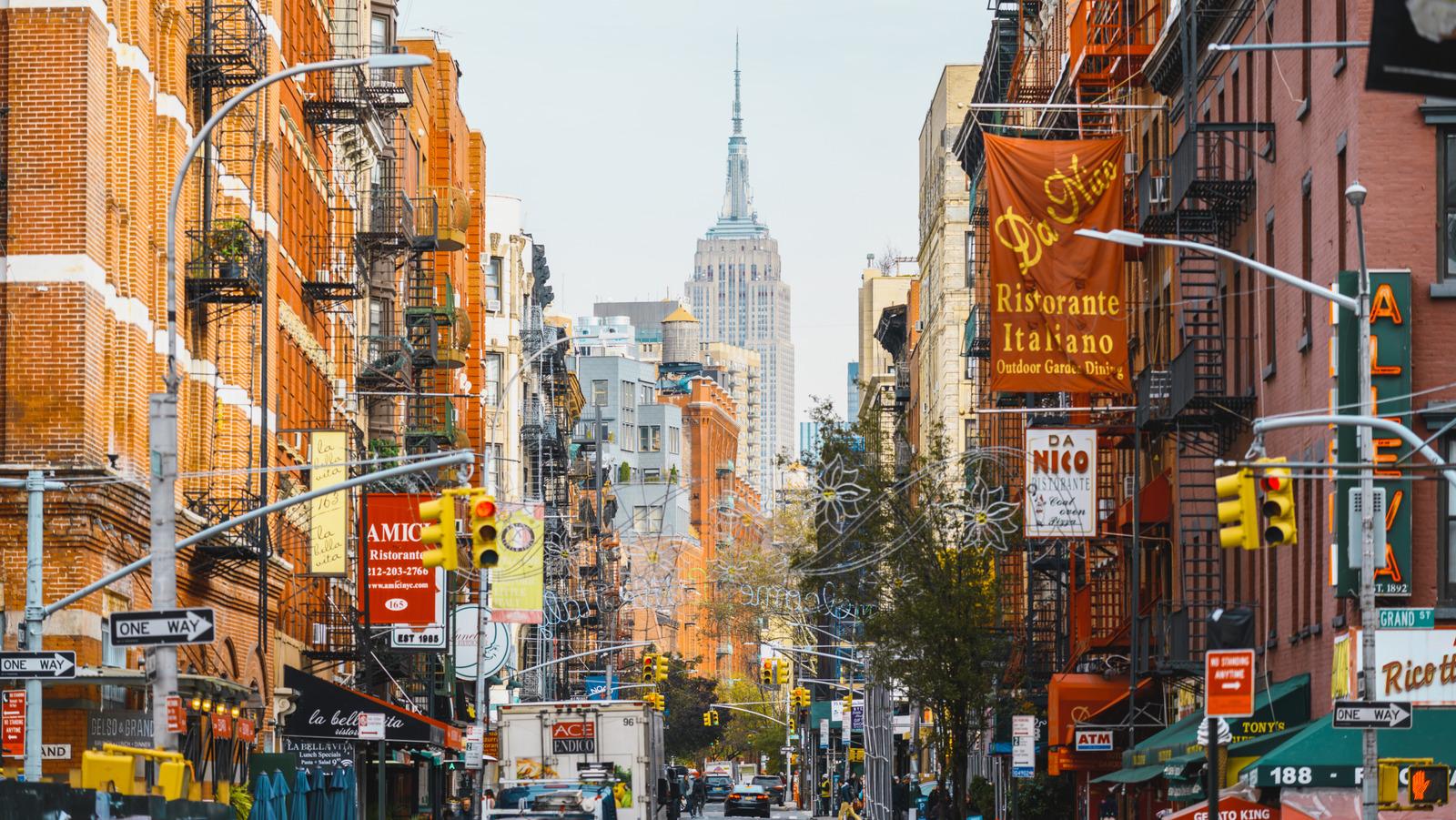
© Marco Bottigelli/Getty Images
New York City is the best restaurant city in the world, until it isn't. For every hidden gem tucked into a basement in Queens, there's a "must-try" Manhattan hotspot serving mediocrity at luxury prices. Much of the city's food scene runs on hype cycles and PR budgets that revolve around a celebrity sighting or a viral TikTok dish, and suddenly you can't get a reservation unless you've won an Oscar or had a philanthropic organization named after you.
This list isn't about trashing New York dining. It's about recalibrating your expectations. These are restaurants that look great on social media and make tourists feel like they've "done" New York, but anyone who actually eats out here regularly knows they're more smoke than substance. Some started out strong and coasted on reputation, while others were born as branding exercises. To be clear, none of these places are disasters. You'll get fed, and you might even enjoy yourself, but if you live here, you can do better. More often than not, there's no need for the pomp. The best pizza places in New York City are some of the best in the world, so if you find yourself jaded by the elitism of the New York dining scene, grab a slice.
Carbone
If you want a chance at seeing a celebrity in New York, head to Carbone. If you want the best Italian food the city has to offer, go elsewhere. The restaurant is owned by Major Food Group, a company that owns several high-end eateries and knows how to hawk an average meal at an exorbitant price.
If you manage to get a reservation (not easy unless you want to eat at 5 p.m. on a Tuesday), you'll notice that the interior has a kind of faux retro charm that's supposed to reflect an upscale version of the Italian-American dining experience. Perhaps I'm also bitter because the space used to belong to Rocco, an classic Italian red sauce restaurant that had been at the address for 90 years and was forced to close when the landlord doubled the rent in 2012.
One of the most famed menu items is the tortellini al ragu, which features exactly eight tortellini on a bed of ragu for $35. And while these luscious little pockets of pasta were deliciously light and perfectly cooked on my visit, they were not worth the hype that surrounds a meal here. There are now also locations in Miami and Las Vegas, a reminder that ultimately, Carbone is a dressed up chain restaurant with an amazing marketing team.
Nougatine
If you want to say you've eaten at a Jean-Georges restaurant without shelling out for the full experience, you'll probably end up at Nougatine. Just know going in that you're not getting the fireworks that made Jean-Georges Vongerichten a legend, but a watered-down, brand-extension version of the same cooking, served in a glossy dining room that exudes digestible corporate interior design.
The food isn't bad, but its price tag is inflated by the fanfare around the Jean-Georges name. The restaurant's famous brunch menu includes classics like a salmon benedict (good) and brioche French toast with caramelized apples (underwhelming), plated in the generically fancy manner you'd expect from a place that charges $14 for a side of French fries. Prices for mains hover in the $20 to $40 range, which would be fine if the food were remarkable, but nothing here will blow your mind. You'll likely walk out wondering why you didn't just grab a proper meal at one of the hundreds of other restaurants in the city that offer comparable food at a much more reasonable price.
Service is brisk and professional, and the room has the manufactured coziness of a business hotel lobby. Tourists love it because it says "Jean-Georges" on the door, but locals know better, or at least they should. If you want to see what made the chef an icon, save up and book the real restaurant.
Bonnie's
I want to get something out of the way: There's a difference between bad and overrated, and while Bonnie's belongs in the latter category, it does not belong in the former. Overall, the dishes here are decent and I appreciate the unique take on what it means to meld two different cuisines, in this case Cantonese and American. That said, in the grand cultural tradition of Williamsburg, Bonnie's just feels like it's trying too hard.
The cacio e pepe mein feels gimmicky, and ultimately is just a standard cacio e pepe with a little umami kick of fermented bean curd and lo mein noodles instead of standard pasta. It's more fun as a concept than a dining experience. Chef Calvin Eng's cha siu bkrib sandwich is more successful as a dish. A take on the McDonald's McRib, a legendary fan favorite, it's plated like a classic American burger but shining with thick, sweet cha siu sauce on a milk bun.
But overall, the dishes at Bonnie's were smaller and greasier than I wanted them to be. It's also on the pricier side, but it's important to take into account that there's a cultural expectation that Chinese food will be cheap and served in massive portions, and treating it like an elevated dining experience is new for many. That said, the hype around Bonnie's is out of step with the quality of the food and if you're looking for Chinese-American fusion fare, there are better options in Brooklyn.
Veselka
Before I begin, I want to make it clear that I appreciate Veselka as a cultural institution. It's been in the East Village since the 1950s, and for that alone, it deserves respect. It's a symbol of the neighborhood's immigrant history and one of the last holdouts from a very different Manhattan. But at some point, it stopped being just a Ukrainian diner and became a brand, and therein lies the problem.
The food is fine, and the menu includes classics like crispy latkes and cozy borscht, a vintage soup that restaurants rarely make anymore. But there's pretty much nothing here you can't find elsewhere, often better, and almost always without a wait. The restaurant's recent expansion and shiny new interiors make it feel more curated than cozy.
If you want to support a piece of Ukrainian-American history, by all means, go. But if you just want the best pierogies, head to any number of smaller Eastern European spots nearby where prices haven't caught up with the Instagram era. Veselka has earned its place in NYC history, but as a restaurant, it's coasting on its reputation.
Cote
Walking into Cote feels less like entering a steakhouse and more like stepping into a nightclub. This isn't a turn-off for everybody, but for how hard it is to get a reservation I wanted to feel a little less like I was in Ibiza. The lights are low, the music hums, and the crowd is a mix of influencers and finance people who probably learned about Cote on TikTok. The restaurant also bears the telltale sign of an overrated restaurant in New York: locations in Miami and Las Vegas.
But there's no denying that the meat is genuinely delicious. The quality is undeniable, with perfectly marbled cuts, expertly grilled right in front of you, that have that buttery, umami-rich flavor that hits every carnivorous instinct. The Butcher's Feast is the menu item to go for, offering four cuts of beef, starters, stews, banchan, and a few sides that are fine but not especially memorable. The food isn't the problem, though.
The issue is the vibe, combined with the feeling that you're paying extra for the privilege of eating in a place that looks better in the two dimensions available on social media than it does in real life. I want to eat at a Korean BBQ spot that feels fun and alive, and Michelin starred Cote lacks sizzling chaos and casual laughter. It's a masterclass in branding and precision, but it's missing warmth and personality.
Junior's
Junior's has three locations in New York City, including the original restaurant in downtown Brooklyn and another in Times Square — a red flag obvious enough to make any New Yorker shudder. There are so many wonderful diners in New York, and maybe decades ago Junior's was one of them, but these days it's an overpriced parody of itself, serving limp sandwiches and soggy fries that make it feel like you could be in a food court at a shopping mall instead of one of a city with some of the world's greatest food.
One of the great tragedies of New York City dining, however, is that if you've got the right real estate, a restaurant can almost guarantee that it'll draw in clientele regardless of the food quality. There's no shortage of tourists willing to pay for mediocre grub in Times Square. And pay they will: The prices at Junior's are astronomical compared to the quality of the food.
But even as big a hater, as I must admit that the regular cheesecake is quite good. It's soft, creamy, with a graham cracker crust that delivers a gently salty, buttery bite. But many of the flavored versions are sugary to the point of being cloying. And while it's not the world's most expensive cheesecake, it's still pretty pricey. If you're thinking about getting a table at Junior's, keep walking in literally any direction for 10 minutes and you'll find a better diner.
Emilio's Ballato
Emilio's Ballato is one of those restaurants that's less about the food and more about the myth. The story goes that it's an old-school red-sauce joint where you might spot a celebrity in the corner and feel like you've been transported to Sinatra's New York. In reality, it's more like a meticulously preserved stage set of that fantasy, complete with prices that remind you that nostalgia comes with a price tag.
The interior is among the most charming I've encountered at an Italian restaurant in New York. Dim lights, scuffed walls, framed photos, and a slightly claustrophobic coziness all add to the downtown allure. They don't take reservations, which adds an air of democracy, but the line can start stretching down the block early, especially on weekends.
If only the food matched the quality of the vibe. The chicken parm (a dish you're unlikely to find in Italy) is hearty, the pasta is decent, and the red sauce tastes about like what you'd expect from an Italian-American restaurant. But it's the kind of meal you could get in the East Village for half the price if you weren't paying for the décor and sense of history. In recent years, Ballato has become more of a scene than a restaurant, a place where people go to feel like they're part of an old New York that doesn't really exist anymore. Emilio's Ballato isn't a bad Italian restaurant, but it makes me question the meaning of authenticity.
Clinton St. Baking Company
There was a time when Clinton St. Baking Company was worth the wait. That time has passed. What was once a charming Lower East Side brunch spot has now become a full-blown tourist magnet, where people line up for over an hour to pay 20 bucks for a stack of pancakes.
Let's talk about those pancakes, because they are the entire reason this place still exists in the public imagination. They're fluffy, buttery, and generously portioned. They're also wildly overpriced and, worse, while they come with a side of maple butter, you have to pay an upcharge for maple syrup. That's not a typo. At a place literally famous for pancakes, syrup costs extra, a concept I simply cannot condone in good conscience. People love to hate brunch, but in recent years it has toppled lunch as the hottest meal of the week, as though there's something about late morning that makes people complacent with mediocre fare.
The rest of the menu offers the greatest hits of brunch clichés like overpriced omelets, chicken and waffles, and a few versions of eggs benedict. The service is harried, the space is cramped, and the vibe reflects a neighborhood gem that's turned into a cash cow.
Artichoke Basille's
There's a reason this spot is only crowded in the wee hours when people who are going home from a night out need something in their stomachs. Any sober reviewer of Artichoke Basille's will agree that this is not the kind of pizza that New York should be associated with. It's open late, the line spills out the door, and every slice is the size of your head. It's also one of the most overrated pizza spots in New York City.
Let's start with the signature slice: the artichoke. It's a thick slab of bread buried under a thick layer of heavy, fatty, creamy artichoke dip. One bite is indulgent, maybe even satisfying. Two bites in, you realize you've made a mistake. I've watched many friends make the mistake of ordering it against my sage advice only for half the slice to end up in the trash can.
The place itself is designed for throughput, not charm, with sticky counters and lackluster decorations that make sure you're in and out. These days, the crowds are mostly tourists and barhoppers who mistake density for quality. And sure, at 2 a.m. after six vodka sodas, a molten, 4-pound slice of dairy sludge might taste like salvation. But in the sober light of day it's more like an endurance test. New York has endless pizza options, from dollar-slice joints to legit Neapolitan masterpieces. Artichoke lands somewhere in the uncanny valley between novelty and hangover cure.
Sadelle's
Sadelle's is what happens when a marketing team decides to rebrand a New York deli to make people think lox is a status symbol. It's owned by Major Food Group (yes, the same people behind Carbone), which should tell you everything: Impeccable branding, stunning interiors, and food that's alarmingly mid given the hype.
The bagels are decently chewy and photogenic, but they're also egregiously overpriced, and the one I got had been toasted to the point of being almost charred. One of my favorite things about New York is a bacon, egg, and cheese sandwich on a toasted everything bagel, which I can get at my local bodega for about five bucks. The one at Sadelle's, although admittedly more refined than the greasy, tin foil-wrapped concoction that I love so dearly, goes for $20: a jaw-dropping number for a self-respecting New Yorker.
The space itself is gorgeous, all pastel tones and mid-century brunch fantasy, filled with the dystopian scene of influencers taking pictures of themselves spreading cream cheese. There's no denying Sadelle's has perfected the "New York experience" aesthetic. But it's an experience designed for tourists, not locals. Real New Yorkers know a great bagel doesn't need chandeliers or a PR team. It just needs to be hot, fresh, and there when you need it. Sadelle's is proof that you can polish a bagel, but at the end of the day, it's just bread with a brand strategy.
Sant Ambroeus
It's not an easy feat for an Italian café to completely lack a sense of warmth, but Sant Ambroeus manages to do just that. It's the kind of restaurant that doubles as a lifestyle brand, a place where you come to be seen sipping an espresso, not to actually enjoy one.
Originally imported from Milan, Sant Ambroeus now has multiple locations across Manhattan and the Hamptons, each nearly identical in their sterile, hyper-curated perfection. The food is perfectly acceptable, featuring competently made pastas and photogenic desserts, most notably the Principessa cake, made with layers of lemon sponge layered with pastry cream and topped with pink almond marzipan. It's beautiful of course, but like most of the experience here, it feels designed more for aesthetic than appetite.
The service is polished to the point of stiffness, and the atmosphere hums with the low buzz of people discussing gallery openings and boarding schools. The coffee is good but not great; the prices, on the other hand, are borderline absurd, with a simple Caesar salad commanding a price tag of $36. Sant Ambroeus nails the quietly luxurious neutral tones of European restraint, but at the expense of the one thing Italian cafés are supposed to have: A soul.
Balthazar

MRI Photos/Shutterstock
Once upon a time, Keith McNally's French brasserie was the place to be for New Yorkers. Celebrities pretended to eat steak frites and everyone else felt lucky just to be in the same room. Now it's the culinary equivalent of an aging It Girl still insisting she's the main character, with a crowd made up of tourists hungry for a New York that may or may not exist.
Balthazar remains a well decorated homage to a French dining experience with red leather banquettes, and the golden light can still fool you into thinking you're in Paris until the server drops off your $23 onion soup. The food is generic French bistro fare like steak frites and moules marinières that probably won't blow your mind.
The crowd is a mix of tourists and people taking business lunches they'll later expense. Locals mostly stopped coming years ago, unless it's for a late-morning croissant (the bakery is still delicious) or an obligatory out-of-town guest dinner. Balthazar isn't bad, it's just a perfectly staged, beautifully lit relic where you can still feel the ghosts of the early 2000s clinking glasses.



